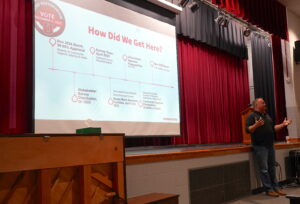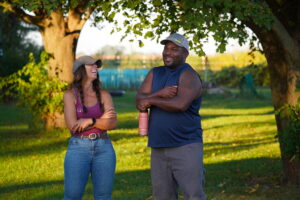Unwinding History: Paving streets in Traer
- Traer’s new brick streets in 1918 looked very attractive except for the horse dung. PHOTO COURTESY OF TRAER HISTORICAL MUSEUM
- The brick pavers on Second Street in downtown Traer were still there in the 1950s. PHOTO COURTESY OF TRAER HISTORICAL MUSEUM
- By 1970, Walnut Street was one of the last remaining brick streets in Traer. Pictured, Hotel Traer. PHOTO COURTESY OF TRAER HISTORICAL MUSEUM

The brick pavers on Second Street in downtown Traer were still there in the 1950s. PHOTO COURTESY OF TRAER HISTORICAL MUSEUM
TRAER – The recent work on Walnut Street raises the question: When were streets paved in Traer? In this third installment of the series Unwinding History, Traer Historical Museum president George Kadrmas explores the answer…
Discussion about improving roads began with the invention of the automobile. Traer City Council members visited other towns with paving projects in 1913. A plan to pave about 10 blocks in 1914 was published in the Traer Star-Clipper on Dec. 19, 1913. The plan called for paving Second Street from Walnut to Linn streets, and Walnut and Main streets from the churches (Fourth Street) to First Street.
The following week, the Star-Clipper reported, “Traer will pave next year, and more extensively than at first contemplated. After the agitation became general by the publication in last week’s paper of the status of the proposition, property owners not affected by the proposed improvement requested that paving come their way, and as a result the officials have included several blocks not contemplated last week.”
The new proposal extended paving on Main Street from Woodlawn Avenue to Sixth Street, Walnut from First Street to Sixth Street.
The city considered several kinds of paving including brick, concrete and asphalt. The Dearborn Construction Company of Waterloo submitted the low bid of $1.99 per square yard using No. 1 vitrified brick. Vitrified brick is fired at extremely high temperatures to achieve a non-porous surface, making the brick exceptionally strong, durable, and water-resistant. Concrete gutters cost 38 cents per foot.

Traer’s new brick streets in 1918 looked very attractive except for the horse dung. PHOTO COURTESY OF TRAER HISTORICAL MUSEUM
Paving specifications were as follows: A foundation of 4 inches of concrete, then 1 1/2 inches of sand, then 4 inches No. 1 vitrified brick. The business street was fully covered by paving, gutters and sidewalks. Second Street south to the railroad, paved 40 feet wide; all other streets, 24 feet wide.
The contract called for work to begin no later than July 15 and to be completed in 60 days. Traer’s first paving project was completed the first week of August in 1914. The total expense of paving was about $34,000.
The first paving project was so popular that more paving projects were completed in 1915 and 1916. Walnut and Main streets were extended south to Seventh Street; Sixth Street paved from Main past Dennis Field; Mill Street from Sixth to Vista; First Street from Walnut to Taylor; all of Woodlawn Avenue; and Fourth Street from Main to Walnut.
Between 1966 and 1970, the City of Traer conducted major curb and gutter projects throughout town. There was opposition from residents to covering the brick with asphalt on Walnut Street. The asphalt, gutters and the 111-year-old brick on Walnut Street have been removed to make way for a new street surface.

By 1970, Walnut Street was one of the last remaining brick streets in Traer. Pictured, Hotel Traer. PHOTO COURTESY OF TRAER HISTORICAL MUSEUM





